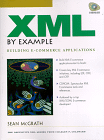XML Applications Just Slightly Ahead of their Time
Covers multiple applications of XML and emerging standards like XSL and XLL, looking over the horizon.
ORIGINAL DRAFT
If you’re interested in XML and its application to electronic commerce, this book is a good investment, providing an advance view of the things to watch for and some of the currently exploitable solutions available. Unfortunately, there are many topics covered by the book which are not quite mature enough to be practical. XML style sheets, for example, or XML-based protocols for online transactions which are still in the specification process, not directly applicable to commercial projects at this time. On the other hand, if you plan to read this book to stay ahead of the curve, you’ll pick up a great deal of information you probably won’t find collected into a single source elsewhere.
This book is divided into four major parts, covering a jumpstart, examples, standards and e-commerce initiatives. Part 1, entitled "Jumpstart", starts with an XML executive summary, presented in a FAQ-like format. Chapter 1, "XML in Action" covers numerous applications in which XML is useful. These include online banking, software distribution, web automation, database integration, localization, intermediate data representation and a chemical markup solution. Chapters 3 and 4 provide compelling arguments in favor of XML commercial use, including competitive advantage and basic market forces. Chapter 5 wraps up section 1 with a high-level overview of XML syntax, setting the stage for a deeper understanding of fundamental principles.
Part 2 starts exploring more concrete examples, covering different client and/or server-based presentation strategies. The second half of Chapter 6 explores XML to HTML conversion using XSL style sheets. Chapter 7 takes a look at using XML to represent database records. Chapter 8 covers the Web Interface Definition Language (WIDL). Chapter 9 looks at the Channel Definition Format (CDF). And Chapter 10 looks at utility design, dividing utilities into read-only and read-write categories. What’s notable about these chapters is that they cover emerging standards that capitalize on XML, either created because of XML or retroactively adjusted to take advantage of XML.
Part 3 takes a closer look at the XML standard and those that enhance XML in one way or another. These include XML itself, XLL (for hypertext linking) and XSL (style sheets for XML). The Unicode standard and DOM (Document Object Model) as well as SGML (XML’s more comprehensive parent) are also covered in this section. These represent a total of 6 chapters, each addressing the topics mentioned above in the same order. Part 4 looks at e-Commerce initiatives. Chapter 17 looks at OFX (Open Financial Exchange), Chapter 18 at XML applied to EDI (Electronic Data Interchange), with Chapter 19 looking at OTP (Open Trading Protocol). Three appendices cover additional details, what’s on the CD and a more in-depth look at the OTP.
If you’re interested in XML, electronic commerce and how these can be applied together, this book is a must. By looking at these existing or emerging standards, you can get ahead of this technology curve and see how large organizations or coalitions are already positioning these solutions to support online transactions and general data interchange. These are important principles affecting the marketplace and worthy of notice for any developer. While this book does not provide as much practical working XML as you might expect from its title, the insights are important and the collection of information is worth the price.
